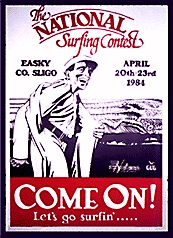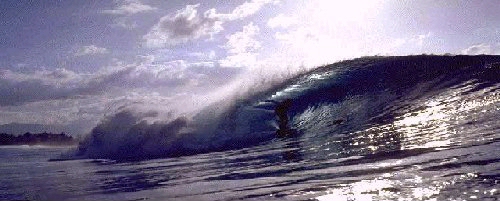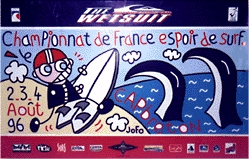

About the time the Irish were defending their shore against vikings like Magnus Bareleg and his compatriots, Hawaii's ancient Polynesian watermen were teasting out their manhood by riding half logs across the Pacific coral (see World Surfing for a comprehensive history of the sport). It was of course many years later that the sport of surfing started its long journey half-way around the world to take advantage of the cool, crisp Irish curls.
Records show that by the late nineteenth century, Hawaiin surfers had travelled to California, but the real exlosion came when Hawaiin surfer Duke Kahanamoku won Olympic gold in swiming in 1912 and 1920 and went on to give exhibitions of surfing in California and Australia in the proceeding years. Over the next twenty five years the sport developed slowly but steadily with competition surfing coming into vogue in the fifties and sixties. In 1964 the first world championships were held in Sydney, and at the same time the International Surfing Federation was formed, the first world governing body of surfing.
This was followed by another momentous event (in terms of Irish surfing at least) - the 1966 Boat Show at the RDS, Dublin. It was at this time that Kevin Cavey, the daddy of all irish surfing, took a stand at the showunder the banner of the Bray Ireland Surf Club. Kevin had read about surfing in Reader's Digest in 1962, and having tried to ride a skimboard made by a local farmer in Kerry he progressed onto a sophisticated craft constructed of marine ply with insulation stuck to the bottom and on this he became Ireland's first kneeboarder. This was not a totl success and neither was Plywood mark 2, except for towing behind boats, so Kevin put in an order for a balsa kit board and in the meantime he headed off to the States. While he was there he took a side trip to Hawaii and surfed Sunset Beach, making the mistake of underestimating the size of the waves and getting pounded by 12 foot surf, but only after catching a 'gasser'. As he dragged himself out of the water, minus his board, he watched the sky fill with American Globemasters taking off from Hickam Field and turning west over the sea for Vietnam.
In California he saw his first fibreglass board, which was lent to him by friendly locals and he surfed Rincon and Huntington Beach with friend Jim Duane.Kevin returned home more convinced than ever that Ireland had consuderable potential for the sport of surfing.
At the '66 Boat Show a few other external influences came to bear. Kevin got in touch with Pat McNulty, editor of surfer magazine (and father of Joe McNulty, the longboarder for Ireland in last year's European championships in Bundoran, and Terry McNulty. These two californian-based surfers also came second for Ireland in the World Big-Wave Championships in Mexico in January '98, behind Brazil, but ahead of such superpowers as USA and Australia. Fuckin' fair play, lads. Anyway, I digress). Pat sent across posters of Greg Knoll at Waimea Bay to help dress the stand, whose main feature was a fifteen foot safety board from the Irish Red Cross. Roger Steadman, honoury Irishman, had just moved to Dublin and he arrived at the show with fibrsglass surfboards and instantly became a member of the new club. Kevin had already caught his very first wave on the finless balsawood board at Gyles Quay in Dundalk in May '65, but America had convinced him that fibreglass was the way forward and he ordered a new board from Doug Wilson at Bilbo for the princely sum of �33.
Things began to move quickly after the Boat Show. In the Spring of '66 Kevin organised the first surfing surfari with his brother Colm, Patrick Kinsella from R.T.E. and American Tom Casey who was soon to be drafted and unfortunately died later in Vietnam. The Bilbo board had arrived and the first stop for the missionaries was Easkey in Co. sligo. From there they travelled up to Bundoran where they managed to get washed up on the rocks (like's many the one since), having headed out into the eye of a westerly storm. A little further north they found friendlier surf at Rossnowlagh where they met up with friends of the family Vinnie and Mary Britton. Vinnie and Mary could both see a place for surfing on the Irish coast and another crictical point in the development of irish surfing occured when they took steps to invlve their young sons Brian, Barry, Conor and William.

From Rossnowlagh, the surfari moved on to Cruit Island, Marble Strand and Portrush where kevin met up with Desmond 'Bow' Vance, with whom he had been corresponding for some time. This liasion put in motion what would turn out tobe a great infusion into the sport.
When they got back from the tour they formed the Surf Club of Ireland, based in Mount Herbert, Bray. The first comittee of the new club consistedof such peolpe as Kevin Cavey, Roger Steadman and Harry Evans who was brought in by Roger, who in turn brought in Aer Lingus pilot Johnny Lee, Henry Howard, Tony Gleeson, Ken and Helen McCabe and the grommet, Brian Britton. Because of Kevin's continous correspondance with Pat McNulty of Surfer Mag, Ireland suddenly recieved an invitation to attend the 1966 World Championships. The club voted Kevin Ireland's firstinternational cap and he flew to San Diego, to California, to represent us at our first world championships. Here he renewed his acquaintance with Rodney Stumper of England, met the legendary Kahanamoku and watched Nat Young bring in the new age of surfing. Kevin, who was sponsored by Gordon & Smith Surfboards, reached the quarter-finals of the contest at Ocean Beach in 4-5 feet surf, so we certainly weren't disgraced.
On his return, Kevin began making regular day trips to Tramore, where he involved some young lifeguards, Hugh O'Brien Moran, Paul and Dave Kenny, Brian Griffin, Justin O'Mahony, Eamon Matthews and the Musgrave brothers. He was helped in this process by Tim Heyland of Tiki, who had begun to make the first of many journeys across the Irish Sea. Roger in the meantime was heading west as a representative of the newly formed C & S Surfboard Company (Cavey and Steadman) with the famous shamrock logo which can still be seen on some of the remaining boards (or bits of boards) from that era. Roger introduced Mike Murphy, Eddie Comber, Frankie McEnnis, Andrew Brislane, Hugh Mine and Sam McCrum to the joys of the sport, while they in turn introduced him to all-night singing and drinking sessions in Lahinch and Ennistymon.
In 1967 the Surf Club of Ireland held the first National Championships at Tramore, thanks to the knowledge Kevin had gained at the '66 World Championships. Rodney Stumper turned up to help as did a journalist from California by the name of Alan Rich along with Tiger Newling, John Trout and Nick Kavanagh from England. Many of the names at that first contest wil be familiar to those on the north coast - names such as Charlie Adgie, Davy Govan, Martin Lloyd and Ted Alexander who came third behind Kevin and Eamon Matthews. Ron Sumpter won the international event. The contest was deemed to be a great success by all and it heralded the dawn of a new era for surfing on this island.
The contest was repeated in '68, once again in Tramore with Ted taking the National title. 1968 also saw the first running of the Irish Intercounty Championships at Rossnowlagh where Down beat Wicklow in the final. As they haven'tt a wave between them its no suprise that neither county has appeared in a final ever since. The following summer, 1969, an Irish team attended the inaugural European Surfing Championships in Jersey in the Channel Islands. Aside from Kevin and Harry Evans of the SCI the team for the first trip was made up of Tramore and North Shore surfers, which began a see-saw relationship between the clubs that still goes on today. The team included Davy Govan, Alan Dukes and Bow Vance from the norty and Eamon Matthews and Dave kenny from the south. The team for the following Europeans in 1970, also in jersey, included a young junior who was to become Ireland's most successful international competitive surfer of all time, Hugh O'Brien Moran. Hugh has been Irish champion on four occasions and he represented Ireland up to 1991 when he retired following a silver medal in the masters division of the European Championships in France. Hugh's influence and popularity in the sport would be hard to overstate, but suffice to say that over 400 people turned up for his retirement dinner in Tramore in '96. Hugh and his wife Margeret, herself former ladies' champion, are now professional photographers and official photographers to the ISA. Another surfer from the early days worthy of special mention was the most innovative of Irish surfers, alan Duke. A few years after the 1969 and 1970 Europeans, Alan, four times Irish champion, was riding his famous six-foot 'Wellington Boot' at a time when most Irish surfers were carefully considering whether to drop below the nine-foot mark. Some never did. Surfers such as Clive Davies of Enniskillen who still rides a ten-foot board which he takes on an annual trip to the North Shore of Hawaii where he counts among his friends some of the top pros of yesteryear.
Another mature longboarder still surfing is Ian Hill from Portrush, father of six times Irish champion Andy Hill. Ian saw surfing for the first time while on holiday in Bude in September 1963 and he bought his first board from Bob Herd of Bilbo in 1964. He surfed Tullan andBundoran on his own all that summer before heading to England where he lived until 1979. Ian could reasonably claim to be Ireland's very first surfer.
In the late sixties members of the Surf Club of Ireland had began to break away to form other clubs leaving the S.C.I. to represent surfers in the Dublin area. The new clubs were the south coast surf club at Tramore, the west coast surf club at Lahinch, The Rossnowlagh Surf Club in Donegal, the North Shore Surf Club in Portrush and in Cork, Tom Flynn, Jean O'Connell, the O'Brien brothers and Jane Cross formed the Fastnet Surf Club. In 1970 the clubs created the Irish Surfing Association, the governing body of surfing in Ireland ever since. Following the first Limerick Leader contest in Tramore in 1971 the ISA decided to accept an offer to host the 1972 European Championships, which was made by the then E.S.F. and later the world governing body president Reginal G. Prytherch of England. The Eurosurf '72 comittee was made up of the West Coast Surf Club, Kevin, Tom Flynn, Harry Evans, Michael Vaughan and the youngsters Ted Alexander and Brian Britton. They organised a highly successful contest in Lahich Co. Clare, which was unfortunately devoid of the essential ingredient of surf.Only the Junior division was held and the winner was Dai Halpin of Wales. However, Ireland's reputation as a surf mecca was created when Spanish Point came on line with classic surf the day after the contest and with the swell up, a major surfari was organised from Lahinchup the coast to Rossnowlagh. That surfari contained many international surfers and they were rewarded for extending their stay with waves of eight to ten feet, gentle offshores and glorious sunshine. The ensuing publicity led to Ireland establishing herself as a surfing venue for visitors from all around the world.
In the early seventies new groups of surfers began to appear - Grant Robinson (who later became National Champion four times and European Masters Champion in 1987), Dave Pierce, Stan Burns, Tom Hickey, the Byrne brothers and Roci Allan (who returned to the sport having first surfed with his sister Susan in Rossnowlagh as far back as 1968 on a board belonging to a friend from the Channel Islands). Youngsters such as Brian Cromie, Wesley and Ashley Moore and Graham Stinson became the second generation of North Shore surfers. Ray McDaid, Kevin McCloskey, Dara Daly and the McGuinness brothers took on the mantle in Rossnowlagh, while a never-ending supply on young Moores began to dominate the South coast. However about this time many of the major names in organised surfing began to take sabbaticals. Harry Evans stepped down due to work pressures, Roger Steadman left Ireland in 1973 with his wife Rosemary to go to Kuala Lumpur and from there to Africa where he still remains. In 1975 Kevin Cavey left for Canada to return six years later and I am happy to report that he still surfs in Ireland today, and is a good friend. 1975 saw the departure of Brian Britton for Zambia, although he returned with renewed enthuasiasm for the sport in 1978.

The mid-seventies was also a transitional time in the development of world surfing. Abroad, the sport had begun to split into two factions. In 1976 professional surfers Fred Hemmings, Randy Rarrick, Peter Townsend and Ian Kearns, who had been running the Pro Classic Trials as well as a number of professional contests such as the Pipeline Masters, the Kahanamoku Classic and the Smirnoff Pro, devised an event rating system that would beusedto determine surfing's first professional World Champion. They also came up with a name for this new concept - International Professional Surfing or I.P.S. (later to become the ASP). This was purely for the professional surfer and it prompted the formation of the first amateur surfing body when the International Surfing Association was formed in 1976 with South African Basil Lombard as its president. Today, the International Surfing Association represents surfers in 44 counteries throughout the world. Through the ISA, surfing finally achieved Olympic status in the winter of 1996 and is expected to be shown as a n exhibition sport in Sydney 2000 and to become a full sport in 2004.
Back in Ireland, surfing was experiencing its own difficulties. The return of Brian Britton heralded the restructuring of Irish surfing and in 1979 the Irish Surfing Association in association with Smirnoff Vodka organised a highly successful international event at Easkey in Co. Sligo. The surf and the weather were perfect and the resultant publicity both at home and abroad took Irish surfing onto a new 'fast track' which culminated in Guinness Eurosurf '85 being held in Bundoran. The Smirnoff International also became a rallying point for those surfers who thought that surfing was becoming too organised and the involvement of a multi-national sponsor was taking surfing too far from its roots. This 'revolution' led to a meeting of all the surfersof Ireland which set out some parameters for the successful development of the sport in Ireland with broad harmony being achieved among all surfers.
However, the success of Guinness Eurosurf '85 and the popularisation of beach culture by TV programmes such as Baywatch and Home & Away combined with the elevation of surf wear to 'trendy' status left the ISA with its hands on the tail of a tiger by the early nineties. Fortunately the combined energies of people such as Brian Britton, Roci Allan, Zoe Lally (Ireland's top woman surfer for many years), Michael 'Sceach' Kelly, Ian Hill and the Fitzgeralds blended with the steadying influence of non-aligned surfers such as Gary Salter, Davy Govan, Willie and Barry Britton and Patsy O'Kane, has led to the development of an extremely vibrant association. The ISA now boasts twelve clubs, runs courses for coaches, beginners and dis-advantaged children, supervises the standards of outdoor pursuits centres and is heavily involved in such diverse areas as Enviromental protection, Health & Safety and Child Protection.
That Ireland has surf to rival any country in the world is not disputed. It can also boast organisers who have chaired the European Surfing Federation for more years than almost anyother country and it currently holds the Vice-Presidency. At world level, an Irish man is currently one of four Vice-Presidents in the International Surfing Association, co-ordinating the development of surfing in the Euro-Africa region. We have produced many international judges of world ranking such as Stan Burns and Irish judges have won acclaim at every level in world surfing. Just last January, the Irish team came second in the World Big Wave Championships in Mexico, behind Brazil alone. The team - consisting of Californian based brothers Joe and Terence McNulty - only got a wild-card call up at the last minute after Tahiti pulled out and finished ahead of such notables as USA and Australia. It greatly boosts Ireland's chances of hosting the Worlds in the near future. (being the decent blokes they are, the brothers sent over the two-foot high trophy a couple of weeks ago, unselfishly acknowledging that Ireland was the best place for it, to serve as a source of inspiration for all.)
The challenge for the next decade is to see whether Irish surfers, through the ISA and its non-aligned friends, can meet the challenge of the pressures beingcreated by the huge increase in the popularity of the sport nd still maintain the friendly welcome for which Ireland has become renowned throughout the world. Only time will tell and in the meantime the wavescontinue to roll in on a coastline that 'has the best surf outside Hawaii'.
